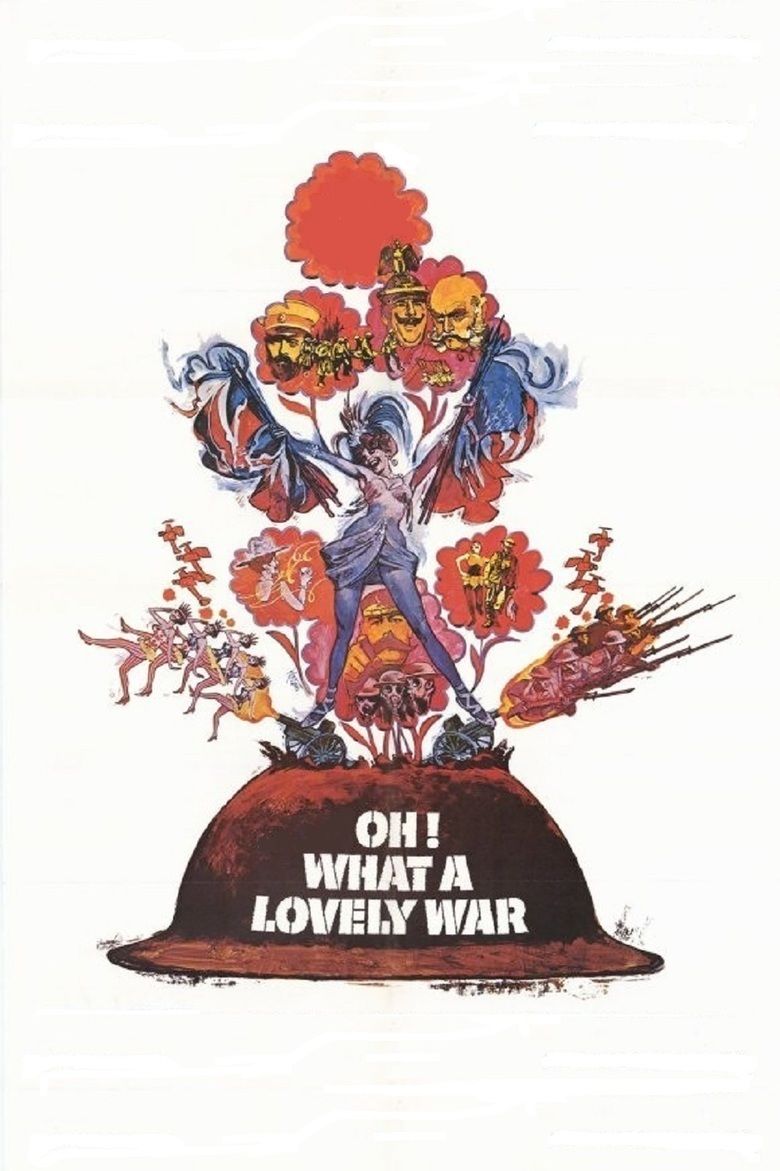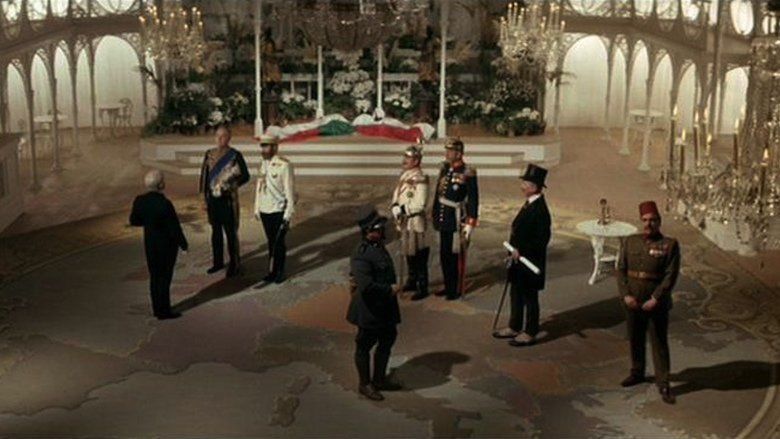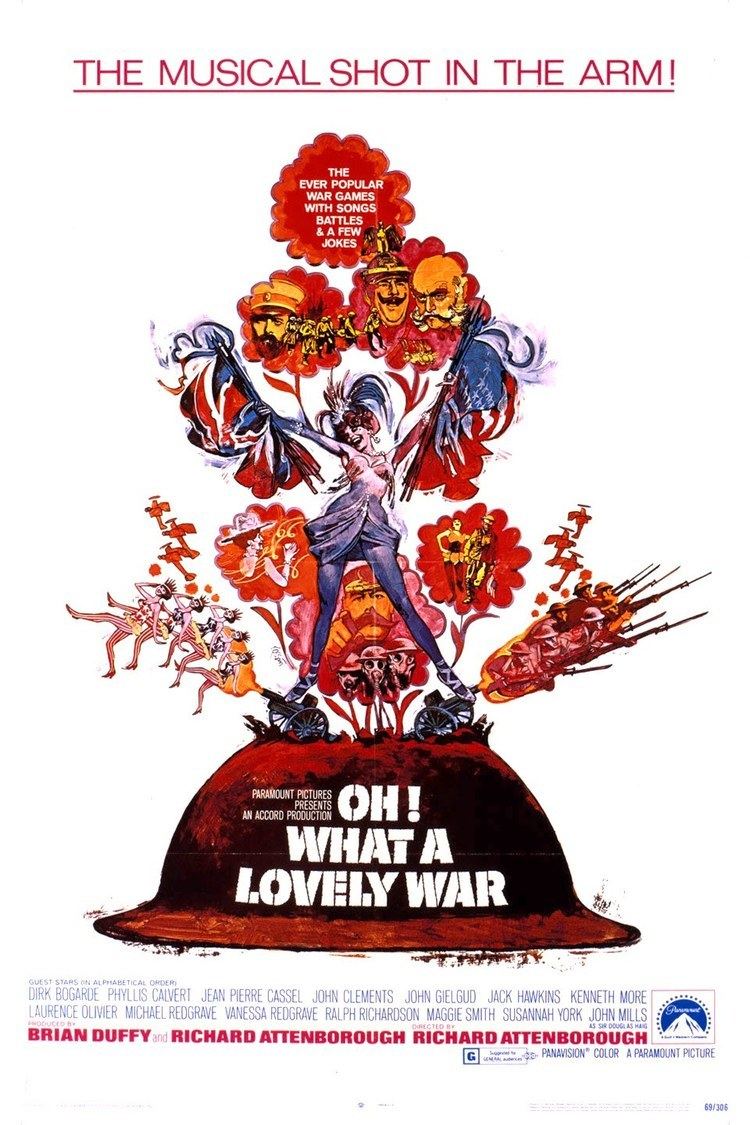Oh! What a Lovely War
8.2 /10 1 Votes
4/4 Roger Ebert Duration Language English | 7.2/10 IMDb 75% Rotten Tomatoes Genre Comedy, Musical, War Country UK | |||||||||||||||||||||||||||||||||
 | ||||||||||||||||||||||||||||||||||
Release date 10 March 1969 (UK release) Initial release April 10, 1969 (United Kingdom) Featured songs The Bells of Hell Go Ting-a-ling-a-ling, Over There, They Didnt Believe Me, Oh! Its a Lovely War Cast (Field Marshal Sir John French), (Sylvia Pankhurst), (Music Hall Star), (Field Marshall Sir Douglas Haig), (Bertie Smith), Maurice Roeves (George Smith)Similar movies Thank You for Smoking , Avatar , Power Cut , War Horse , Look Who's Back , This Is the End Tagline The ever popular war games. With songs, battles & a few jokes | ||||||||||||||||||||||||||||||||||
Oh what a lovely war end sequence
Oh! What a Lovely War is a 1969 British comedy musical film directed by Richard Attenborough (in his directorial debut), with an ensemble cast including Maggie Smith, Dirk Bogarde, John Gielgud, John Mills, Kenneth More, Laurence Olivier, Jack Hawkins, Corin Redgrave, Michael Redgrave, Vanessa Redgrave, Ralph Richardson, Ian Holm, Paul Shelley, Malcolm McFee, Jean-Pierre Cassel, Nanette Newman, Edward Fox, Susannah York, John Clements, Phyllis Calvert and Maurice Roëves.
Contents
- Oh what a lovely war end sequence
- Sylvia pankhurst in oh what a lovely war 1969
- Synopsis
- Smith family
- Guest stars
- Production
- The song
- Box office
- Awards
- References

The film is based on the stage musical Oh, What a Lovely War!, originated by Charles Chilton as a radio play, The Long Long Trail in December 1961, and transferred to stage by Gerry Raffles in partnership with Joan Littlewood and her Theatre Workshop in 1963.

The title is derived from the music hall song Oh! It's a Lovely War, which is one of the major numbers in the film.

Sylvia pankhurst in oh what a lovely war 1969
Synopsis
Oh! What A Lovely War summarises and comments on the events of the First World War using popular songs of the time, many of which were parodies of older popular songs, and using allegorical settings such as Brighton's West Pier to criticise the manner in which the eventual victory was won.
The diplomatic manoeuvrings and events involving those in authority are set in a fantasy location inside the pierhead pavilion, far from the trenches. In the opening scene various Foreign Ministers, generals and Heads of State walk over a huge map of Europe, reciting actual words spoken by these figures at the time. An unnamed photographer takes a picture of Europe's rulers – after handing two red poppies to the Archduke Ferdinand and his wife, the Duchess of Hohenberg, he takes their picture, 'assassinating' them as the flash goes off. Many of the heads of state enjoy good personal relations and are reluctant to go to war: a tearful Emperor Franz Josef declares war on Serbia after being deceived by his Foreign Minister, whilst Czar Nicholas II and Kaiser Wilhelm II are shown as unable to overrule their countries' military mobilisation schedules. The German invasion of Belgium leaves Sir Edward Grey little choice but to get involved. Italy reneges on her alliance with the Central Powers (she joined the Allies in 1915) but Turkey joins them instead.
The start of the war in 1914 is shown as a parade of optimism. The protagonists are an archetypal British family of the time, the Smiths, who are shown entering Brighton's West Pier, with General Haig selling tickets – the film later follows the young Smith men through their experiences in the trenches. A military band rouses holidaymakers from the beach to rally round and follow – some even literally boarding a bandwagon. The first Battle of Mons is similarly cheerfully depicted yet more realistic in portrayal. Both scenes are flooded in pleasant sunshine.
When the casualties start to mount, a theatre audience is rallied by singing "Are We Downhearted? No!" A chorus line dressed in frilled yellow dresses, recruits a volunteer army with "We don't want to lose you, but we think you ought to go". A music hall star (Maggie Smith) then enters a lone spotlight, and lures the still doubtful young men in the audience into "taking the King's Shilling" by singing about how every day she 'walks out' with different men in uniform, and that "On Saturday I'm willing, if you'll only take the shilling, to make a man of any one of you." The young men take to the stage and are quickly moved offstage and into military life, and the initially alluring music hall singer is depicted on close-up as a coarse, over-made-up harridan.
The red poppy crops up again as a symbol of impending death, often being handed to a soldier about to be sent to die. These scenes are juxtaposed with the pavilion, now housing the top military brass. There is a scoreboard (a dominant motif in the original theatre production) showing the loss of life and 'yards gained'.
Outside, Sylvia Pankhurst (Vanessa Redgrave) is shown addressing a hostile crowd on the futility of war, upbraiding them for believing everything they read in the newspapers. She is met with catcalls and jeered off her podium.
1915 is depicted as darkly contrasting in tone. Many shots of a parade of wounded men illustrate an endless stream of grim, hopeless faces. Black humour among these soldiers has now replaced the enthusiasm of the early days. "There's a Long, Long Trail a-Winding" captures the new mood of despair, depicting soldiers filing along in torrential rain in miserable conditions. Red poppies provide the only bright colour in these scenes. In a scene of British soldiers drinking in an estaminet, a chanteuse (Pia Colombo) leads them in a jolly chorus of "The Moon Shines Bright on Charlie Chaplin", a reworking of an American song then shifts the mood back to darker tone by singing a soft and sombre version of "Adieu la vie". At the end of the year, amidst more manoeuvres in the pavilion, General (later Field Marshal) Douglas Haig replaces Field Marshal Sir John French as Commander-in-Chief of the British Forces. Haig is then mocked by Australian troops who see him inspecting British soldiers; they sing "They were only playing Leapfrog" to the tune of "John Brown".
An interfaith religious service is held in a ruined abbey. A priest tells the gathered soldiers that each religion has endorsed the war by way of allowing soldiers to eat pork if Jewish, meat on Fridays if Catholic, and work through the sabbath if in service of the war for all religions. He also says the Dalai Lama has blessed the war effort.
1916 passes and the film's tone darkens again. The songs contain contrasting tones of wistfulness, stoicism, and resignation; including "The Bells of Hell Go Ting-a-ling-a-ling", "If The Sergeant Steals Your Rum, Never Mind" and "Hanging on the Old Barbed Wire". The wounded are laid out in ranks at the field station, a stark contrast to the healthy rows of young men who entered the War. The camera often lingers on Harry Smith's silently suffering face.
The Americans arrive, but are shown only in the 'disconnected reality' of the pavilion, interrupting the deliberations of the British generals by singing "Over There" with the changed final line: "And we won't come back – we'll be buried over there!" The resolute-looking American captain seizes the map from an astonished Haig.
Jack notices with disgust that after three years of fighting, he is literally back where he started, at Mons. As the Armistice is sounding, Jack is the last one to die. There is a splash of red which at first glance appears to be blood, but which turns out to be yet another poppy out of focus in the foreground. Jack's spirit wanders through the battlefield, and he eventually finds himself in the room where the elder statesmen of Europe are drafting the coming peace - but they are oblivious to his presence. Jack finally finds himself on a tranquil hillside, where he joins his friends for a lie down on the grass, where their figures morph into crosses. The film closes with a long slow pan out that ends in a dizzying aerial view of countless soldiers' graves, as the voices of the dead sing "We'll Never Tell Them" (a parody of the Jerome Kern song "They Didn't Believe Me").
Smith family
At the time, the Beatles were also interested in making an anti-war film. At Bertrand Russell’s suggestion Paul McCartney met with the producer Len Deighton to discuss the opportunity of the band portraying the Smith family although in the end it was not possible to arrange.
Guest stars
Production
The producers were the novelist Len Deighton, photographer Brian Duffy, and Richard Attenborough, who was making his directorial debut. The Deighton Duffy production company had produced the film adaptation of Deighton’s Only When I Larf starring Richard Attenborough. Deighton wrote the screenplay for Oh! What a Lovely War and the opening title sequence was created by Len Deighton's lifelong friend Raymond Hawkey, the designer responsible for many of Deighton's book covers in the 1960s. In an attempt to shame other people who he thought were claiming credit for things they hadn't actually done, Deighton decided not to be listed in the film credits, a gesture he later described as "stupid and infantile".
The 1969 film transferred the mise-en-scène completely into the cinematic domain, with elaborate sequences shot at West Pier, Brighton, elsewhere in Brighton and on the South Downs, interspersed with motifs from the stage production. These included the 'cricket' scoreboards showing the number of dead, but Deighton did not use the pierrot costumes. However, as many critics, including Pauline Kael, noted, the treatment diminished the effect of the numbers of deaths, which appear only fleetingly. Nonetheless, Deighton’s final sequence, ending in a helicopter shot of thousands of war graves is regarded as one of the most memorable moments of the film. According to Attenborough, sixteen thousand white crosses had to be hammered into individually dug holes due to the hardness of the soil. Although this is effective in symbolising the scale of death, the number of crosses was in fact less than the number of deaths in a single battle.
The film was shot in the summer of 1968 in Sussex, mostly in the Brighton area. Many of the extras were local folk, but a great many were students from the University of Sussex, Falmer, on the outskirts of the city. The film's locations included the West Pier (now virtually demolished), Ditchling Beacon, Sheepcote Valley (the trench sequences), Old Bayham Abbey, near Frant (the church parade), Brighton station and Ovingdean (where hundreds of crosses were erected for the classic finale).
The song
The song was written by J. P. Long and Maurice Scott in 1917 and was part of the repertoire of music hall star and male impersonator Ella Shields. The first verse and the chorus follow:
Up to your waist in water,Up to your eyes in slush –Using the kind of language,That makes the sergeant blush;Who wouldn't join the army?That's what we all inquire,Don't we pity the poor civilians sitting beside the fire.ChorusOh! Oh! Oh! it's a lovely war,Who wouldn't be a soldier eh?Oh! It's a shame to take the pay.As soon as reveille is goneWe feel just as heavy as lead,But we never get up till the sergeant bringsOur breakfast up to bedOh! Oh! Oh! it's a lovely war,What do we want with eggs and hamWhen we've got plum and apple jam?Form fours! Right turn!How shall we spend the money we earn?Oh! Oh! Oh! it's a lovely war.Two pre-musical renditions, one from 1918, can be found at Firstworldwar.com. Almost all of the songs featured in the film also appear on the CD41 album series Oh! It's A Lovely War (four volumes).
Box office
It was the 16th most popular film at the UK box office in 1969.
Awards
References
Oh! What a Lovely War WikipediaOh! What a Lovely War IMDbOh! What a Lovely War Roger EbertOh! What a Lovely War Rotten TomatoesOh! What a Lovely War themoviedb.org
